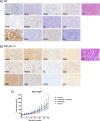Intratumor genetic heterogeneity and clonal evolution to decode endometrial cancer progression
- PMID: 35145232
- PMCID: PMC8956509
- DOI: 10.1038/s41388-022-02221-0
Intratumor genetic heterogeneity and clonal evolution to decode endometrial cancer progression
Abstract
Analyzing different tumor regions by next generation sequencing allows the assessment of intratumor genetic heterogeneity (ITGH), a phenomenon that has been studied widely in some tumor types but has been less well explored in endometrial carcinoma (EC). In this study, we sought to characterize the spatial and temporal heterogeneity of 9 different ECs using whole-exome sequencing, and by performing targeted sequencing validation of the 42 primary tumor regions and 30 metastatic samples analyzed. In addition, copy number alterations of serous carcinomas were assessed by comparative genomic hybridization arrays. From the somatic mutations, identified by whole-exome sequencing, 532 were validated by targeted sequencing. Based on these data, the phylogenetic tree reconstructed for each case allowed us to establish the tumors' evolution and correlate this to tumor progression, prognosis, and the presence of recurrent disease. Moreover, we studied the genetic landscape of an ambiguous EC and the molecular profile obtained was used to guide the selection of a potential personalized therapy for this patient, which was subsequently validated by preclinical testing in patient-derived xenograft models. Overall, our study reveals the impact of analyzing different tumor regions to decipher the ITGH in ECs, which could help make the best treatment decision.
© 2022. The Author(s).
Conflict of interest statement
JSR-F reports receiving personal/consultancy fees from Goldman Sachs, REPARE Therapeutics, Paige.AI and Eli Lilly, membership of the scientific advisory boards of VolitionRx, REPARE Therapeutics and Paige.AI, membership of the Board of Directors of Grupo Oncoclinicas, and ad hoc membership of the scientific advisory boards of Roche Tissue Diagnostics, Ventana Medical Systems, Novartis, Genentech and InVicro, outside the scope of this study. BW reports ad hoc membership of the scientific advisory board of REPARE Therapeutics, outside the scope of this study. The remaining authors have no conflict of interests to declare.
Figures







Similar articles
-
Cell Culture System for Analysis of Genetic Heterogeneity Within Hepatocellular Carcinomas and Response to Pharmacologic Agents.Gastroenterology. 2017 Jan;152(1):232-242.e4. doi: 10.1053/j.gastro.2016.09.008. Epub 2016 Sep 14. Gastroenterology. 2017. PMID: 27639803
-
Assessing intratumor heterogeneity and tracking longitudinal and spatial clonal evolutionary history by next-generation sequencing.Proc Natl Acad Sci U S A. 2016 Sep 13;113(37):E5528-37. doi: 10.1073/pnas.1522203113. Epub 2016 Aug 29. Proc Natl Acad Sci U S A. 2016. PMID: 27573852 Free PMC article.
-
Genetic Heterogeneity in Therapy-Naïve Synchronous Primary Breast Cancers and Their Metastases.Clin Cancer Res. 2017 Aug 1;23(15):4402-4415. doi: 10.1158/1078-0432.CCR-16-3115. Epub 2017 Mar 28. Clin Cancer Res. 2017. PMID: 28351929 Free PMC article.
-
Genomic complexity of multiple myeloma and its clinical implications.Nat Rev Clin Oncol. 2017 Feb;14(2):100-113. doi: 10.1038/nrclinonc.2016.122. Epub 2016 Aug 17. Nat Rev Clin Oncol. 2017. PMID: 27531699 Review.
-
Quantitative Clinical Imaging Methods for Monitoring Intratumoral Evolution.Methods Mol Biol. 2017;1513:61-81. doi: 10.1007/978-1-4939-6539-7_6. Methods Mol Biol. 2017. PMID: 27807831 Review.
Cited by
-
Endometrial cancer at recurrence: To re-sequence or not to re-sequence.Gynecol Oncol Rep. 2024 May 9;53:101414. doi: 10.1016/j.gore.2024.101414. eCollection 2024 Jun. Gynecol Oncol Rep. 2024. PMID: 38841264 Free PMC article. No abstract available.
-
Role of cfDNA and ctDNA to improve the risk stratification and the disease follow-up in patients with endometrial cancer: towards the clinical application.J Exp Clin Cancer Res. 2024 Sep 20;43(1):264. doi: 10.1186/s13046-024-03158-w. J Exp Clin Cancer Res. 2024. PMID: 39304963 Free PMC article.
-
Dedifferentiated umbilical metastases from low grade endometrioid endometrial adenocarcinoma complicated by super-obesity: A case report.Int J Surg Case Rep. 2023 Jul;108:108449. doi: 10.1016/j.ijscr.2023.108449. Epub 2023 Jul 1. Int J Surg Case Rep. 2023. PMID: 37406534 Free PMC article.
-
Molecular features for timely cancer diagnosis and treatment - tumors of the ovary, fallopian tube and endometrium.Virchows Arch. 2024 Feb;484(2):339-351. doi: 10.1007/s00428-023-03710-7. Epub 2023 Dec 15. Virchows Arch. 2024. PMID: 38099957 Review.
-
A ciprofloxacin derivative with four mechanisms of action overcomes paclitaxel resistance in p53-mutant and MDR1 gene-expressing type II human endometrial cancer.Biomaterials. 2023 May;296:122093. doi: 10.1016/j.biomaterials.2023.122093. Epub 2023 Mar 17. Biomaterials. 2023. PMID: 36965280 Free PMC article.
References
-
- Siegel RL, Miller KD, Jemal A. Cancer statistics, 2020. CA Cancer J Clin. 2020;70:7–30. - PubMed
-
- Bokhman JV. Two pathogenetic types of endometrial carcinoma. Gynecol Oncol. 1983;15:10–7. - PubMed
-
- Lax SF, Kurman RJ. A dualistic model for endometrial carcinogenesis based on immunohistochemical and molecular genetic analyses. Verh Dtsch Ges Pathol. 1997;81:228–32. - PubMed
-
- Soslow RA. Endometrial carcinomas with ambiguous features. Semin Diagn Pathol. 2010;27:261–73.. - PubMed
Publication types
MeSH terms
Grants and funding
LinkOut - more resources
Full Text Sources
Molecular Biology Databases

